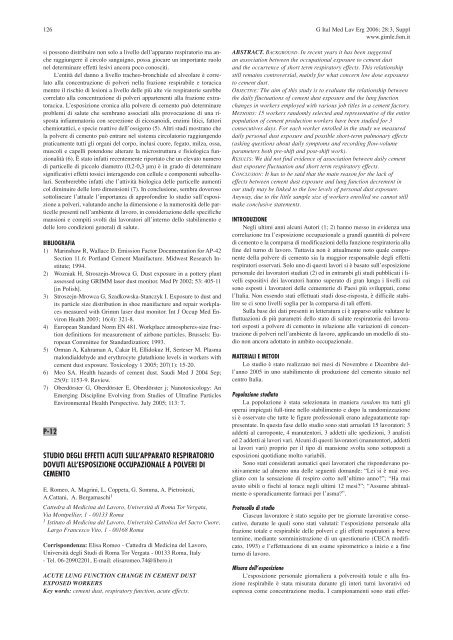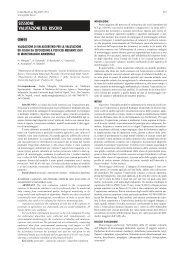Indice - Giornale Italiano di Medicina del Lavoro ed Ergonomia ...
Indice - Giornale Italiano di Medicina del Lavoro ed Ergonomia ...
Indice - Giornale Italiano di Medicina del Lavoro ed Ergonomia ...
You also want an ePaper? Increase the reach of your titles
YUMPU automatically turns print PDFs into web optimized ePapers that Google loves.
126 G Ital M<strong>ed</strong> Lav Erg 2006; 28:3, Suppl<br />
www.gimle.fsm.it<br />
si possono <strong>di</strong>stribuire non solo a livello <strong>del</strong>l’apparato respiratorio ma anche<br />
raggiungere il circolo sanguigno, possa giocare un importante ruolo<br />
nel determinare effetti lesivi ancora poco conosciti.<br />
L’entità <strong>del</strong> danno a livello tracheo-bronchiale <strong>ed</strong> alveolare è correlato<br />
alla concentrazione <strong>di</strong> polveri nella frazione respirabile e toracica<br />
mentre il rischio <strong>di</strong> lesioni a livello <strong>del</strong>le più alte vie respiratorie sarebbe<br />
correlato alla concentrazione <strong>di</strong> polveri appartenenti alla frazione extratoracica.<br />
L’esposizione cronica alla polvere <strong>di</strong> cemento può determinare<br />
problemi <strong>di</strong> salute che sembrano associati alla provocazione <strong>di</strong> una risposta<br />
infiammatoria con secrezione <strong>di</strong> eicosanoi<strong>di</strong>, enzimi litici, fattori<br />
chemiotattici, e specie reattive <strong>del</strong>l’ossigeno (5). Altri stu<strong>di</strong> mostrano che<br />
la polvere <strong>di</strong> cemento può entrare nel sistema circolatorio raggiungendo<br />
praticamente tutti gli organi <strong>del</strong> corpo, inclusi cuore, fegato, milza, ossa,<br />
muscoli e capelli potendone alterare la microstruttura e fisiologica funzionalità<br />
(6). È stato infatti recentemente riportato che un elevato numero<br />
<strong>di</strong> particelle <strong>di</strong> piccolo <strong>di</strong>ametro (0,2-0,3 µm) è in grado <strong>di</strong> determinare<br />
significativi effetti tossici interagendo con cellule e componenti subcellulari.<br />
Sembrerebbe infatti che l’attività biologica <strong>del</strong>le particelle aumenti<br />
col <strong>di</strong>minuire <strong>del</strong>le loro <strong>di</strong>mensioni (7). In conclusione, sembra doveroso<br />
sottolineare l’attuale l’importanza <strong>di</strong> approfon<strong>di</strong>re lo stu<strong>di</strong>o sull’esposizione<br />
a polveri, valutando anche la <strong>di</strong>mensione e la numerosità <strong>del</strong>le particelle<br />
presenti nell’ambiente <strong>di</strong> lavoro, in considerazione <strong>del</strong>le specifiche<br />
mansioni e compiti svolti dai lavoratori all’interno <strong>del</strong>lo stabilimento e<br />
<strong>del</strong>le loro con<strong>di</strong>zioni generali <strong>di</strong> salute.<br />
BIBLIOGRAFIA<br />
1) Marinshaw R, Wallace D. Emission Factor Documentation for AP-42<br />
Section 11.6: Portland Cement Manifacture. Midwest Research Institute;<br />
1994.<br />
2) Wozniak H, Stroszejn-Mrowca G. Dust exposure in a pottery plant<br />
assess<strong>ed</strong> using GRIMM laser dust monitor. M<strong>ed</strong> Pr 2002; 53: 405-11<br />
[in Polish].<br />
3) Stroszejn-Mrowca G, Szadkowska-Stanczyk I. Exposure to dust and<br />
its particle size <strong>di</strong>stribution in shoe manifacture and repair workplaces<br />
measur<strong>ed</strong> with Grimm laser dust monitor. Int J Occup M<strong>ed</strong> Environ<br />
Health 2003; 16(4): 321-8.<br />
4) European Standard Norm EN 481. Workplace atmospheres-size fraction<br />
definitions for measurement of airbone particles. Brussels: European<br />
Committee for Standar<strong>di</strong>zation; 1993.<br />
5) Orman A, Kahraman A, Cakar H, Ellidokuz H, Serteser M. Plasma<br />
malon<strong>di</strong>aldehyde and erythrocyte glutathione levels in workers with<br />
cement dust exposure. Toxicology 1 2005; 207(1): 15-20.<br />
6) Meo SA. Health hazards of cement dust. Sau<strong>di</strong> M<strong>ed</strong> J 2004 Sep;<br />
25(9): 1153-9. Review.<br />
7) Oberdörster G, Oberdörster E, Oberdörster j; Nanotoxicology: An<br />
Emerging Discipline Evolving from Stu<strong>di</strong>es of Ultrafine Particles<br />
Environmental Health Perspective. July 2005; 113: 7.<br />
P-12<br />
STUDIO DEGLI EFFETTI ACUTI SULL’APPARATO RESPIRATORIO<br />
DOVUTI ALL’ESPOSIZIONE OCCUPAZIONALE A POLVERI DI<br />
CEMENTO<br />
E. Romeo, A. Magrini, L. Coppeta, G. Somma, A. Pietroiusti,<br />
A.Cattani, A. Bergamaschi1 Catt<strong>ed</strong>ra <strong>di</strong> Me<strong>di</strong>cina <strong>del</strong> <strong>Lavoro</strong>, Università <strong>di</strong> Roma Tor Vergata,<br />
Via Montpellier, 1 - 00133 Roma<br />
1 Istituto <strong>di</strong> Me<strong>di</strong>cina <strong>del</strong> <strong>Lavoro</strong>, Università Cattolica <strong>del</strong> Sacro Cuore,<br />
Largo Francesco Vito, 1 - 00168 Roma<br />
Corrispondenza: Elisa Romeo - Catt<strong>ed</strong>ra <strong>di</strong> Me<strong>di</strong>cina <strong>del</strong> <strong>Lavoro</strong>,<br />
Università degli Stu<strong>di</strong> <strong>di</strong> Roma Tor Vergata - 00133 Roma, Italy<br />
- Tel. 06-20902201, E-mail: elisaromeo.74@libero.it<br />
ACUTE LUNG FUNCTION CHANGE IN CEMENT DUST<br />
EXPOSED WORKERS<br />
Key words: cement dust, respiratory function, acute effects.<br />
ABSTRACT. BACKGROUND. In recent years it has been suggest<strong>ed</strong><br />
an association between the occupational exposure to cement dust<br />
and the occurrence of short term respiratory effects. This relationship<br />
still remains controversial, mainly for what concern low dose exposures<br />
to cement dust.<br />
OBJECTIVE: The aim of this study is to evaluate the relationship between<br />
the daily fluctuations of cement dust exposure and the lung function<br />
changes in workers employ<strong>ed</strong> with various job titles in a cement factory.<br />
METHODS: 15 workers randomly select<strong>ed</strong> and representative of the entire<br />
population of cement production workers have been stu<strong>di</strong><strong>ed</strong> for 3<br />
consecutives days. For each worker enroll<strong>ed</strong> in the study we measur<strong>ed</strong><br />
daily personal dust exposure and possible short-term pulmonary effects<br />
(asking questions about daily symptoms and recor<strong>di</strong>ng flow-volume<br />
parameters both pre-shift and post-shift work).<br />
RESULTS: We <strong>di</strong>d not find evidence of association between daily cement<br />
dust exposure fluctuation and short term respiratory effects.<br />
CONCLUSION: It has to be said that the main reason for the lack of<br />
effects between cement dust exposure and lung function decrement in<br />
our study may be link<strong>ed</strong> to the low levels of personal dust exposure.<br />
Anyway, due to the little sample size of workers enroll<strong>ed</strong> we cannot still<br />
make conclusive statements.<br />
INTRODUZIONE<br />
Negli ultimi anni alcuni Autori (1; 2) hanno messo in evidenza una<br />
correlazione tra l’esposizione occupazionale a gran<strong>di</strong> quantità <strong>di</strong> polvere<br />
<strong>di</strong> cemento e la comparsa <strong>di</strong> mo<strong>di</strong>ficazioni <strong>del</strong>la funzione respiratoria alla<br />
fine <strong>del</strong> turno <strong>di</strong> lavoro. Tuttavia non è attualmente noto quale componente<br />
<strong>del</strong>la polvere <strong>di</strong> cemento sia la maggior responsabile degli effetti<br />
respiratori osservati. Solo uno <strong>di</strong> questi lavori si è basato sull’esposizione<br />
personale dei lavoratori stu<strong>di</strong>ati (2) <strong>ed</strong> in entrambi gli stu<strong>di</strong> pubblicati i livelli<br />
espositivi dei lavoratori hanno superato <strong>di</strong> gran lunga i livelli cui<br />
sono esposti i lavoratori <strong>del</strong>le cementerie <strong>di</strong> Paesi più sviluppati, come<br />
l’Italia. Non essendo stati effettuati stu<strong>di</strong> dose-risposta, è <strong>di</strong>fficile stabilire<br />
se ci sono livelli soglia per la comparsa <strong>di</strong> tali effetti.<br />
Sulla base dei dati presenti in letteratura ci è apparso utile valutare le<br />
fluttuazioni <strong>di</strong> più parametri <strong>del</strong>lo stato <strong>di</strong> salute respiratoria dei lavoratori<br />
esposti a polvere <strong>di</strong> cemento in relazione alle variazioni <strong>di</strong> concentrazione<br />
<strong>di</strong> polveri nell’ambiente <strong>di</strong> lavoro, applicando un mo<strong>del</strong>lo <strong>di</strong> stu<strong>di</strong>o<br />
non ancora adottato in ambito occupazionale.<br />
MATERIALI E METODI<br />
Lo stu<strong>di</strong>o è stato realizzato nei mesi <strong>di</strong> Novembre e Dicembre <strong>del</strong>l’anno<br />
2005 in uno stabilimento <strong>di</strong> produzione <strong>del</strong> cemento situato nel<br />
centro Italia.<br />
Popolazione stu<strong>di</strong>ata<br />
La popolazione è stata selezionata in maniera random tra tutti gli<br />
operai impiegati full-time nello stabilimento e dopo la randomizzazione<br />
si è osservato che tutte le figure professionali erano adeguatamente rappresentate.<br />
In questa fase <strong>del</strong>lo stu<strong>di</strong>o sono stati arruolati 15 lavoratori: 3<br />
addetti al carroponte, 4 manutentori, 3 addetti alle spe<strong>di</strong>zioni, 3 analisti<br />
<strong>ed</strong> 2 addetti ai lavori vari. Alcuni <strong>di</strong> questi lavoratori (manutentori, addetti<br />
ai lavori vari) proprio per il tipo <strong>di</strong> mansione svolta sono sottoposti a<br />
esposizioni quoti<strong>di</strong>ane molto variabili.<br />
Sono stati considerati asmatici quei lavoratori che rispondevano positivamente<br />
ad almeno una <strong>del</strong>le seguenti domande: “Lei si è mai svegliato<br />
con la sensazione <strong>di</strong> respiro corto nell’ultimo anno?”; “Ha mai<br />
avuto sibili o fischi al torace negli ultimi 12 mesi?”; “Assume abitualmente<br />
o spora<strong>di</strong>camente farmaci per l’asma?”.<br />
Protocollo <strong>di</strong> stu<strong>di</strong>o<br />
Ciascun lavoratore è stato seguito per tre giornate lavorative consecutive,<br />
durante le quali sono stati valutati: l’esposizione personale alla<br />
frazione totale e respirabile <strong>del</strong>le polveri e gli effetti respiratori a breve<br />
termine, me<strong>di</strong>ante somministrazione <strong>di</strong> un questionario (CECA mo<strong>di</strong>ficato,<br />
1993) e l’effettuazione <strong>di</strong> un esame spirometrico a inizio e a fine<br />
turno <strong>di</strong> lavoro.<br />
Misura <strong>del</strong>l’esposizione<br />
L’esposizione personale giornaliera a polverosità totale e alla frazione<br />
respirabile è stata misurata durante gli interi turni lavorativi <strong>ed</strong><br />
espressa come concentrazione me<strong>di</strong>a. I campionamenti sono stati effet-
















